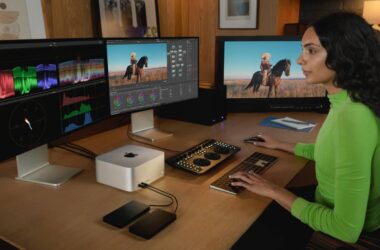The virtual world is great for tricking your brain into seeing things that aren’t actually there, but what about your ears? At SXSW this year, Sony has something for that, too.
Virtual reality may finally be a product that people can see and experience at home, but it has been a long journey, and one primarily catered for your eyes.
Manipulating your brain into believing you’re somewhere else is one that you need two sets of images for and a compass, with the former acting like eyes and the latter giving you a sense of position. Put them together and you have the virtual recreation of you, a head that you essentially wear to experience life in the digital world, be it filmed or rendered by video games.
It’s an experience you can try for yourself either in dedicated VR setups like the HTC Vive, Sony PlayStation VR, or the Oculus Rift, or something you can take mobile thanks to the Google Daydream View VR and Samsung’s Gear VR, but these experiences all have one thing in common: they cater to the eyes.
Virtual reality isn’t supposed to be solely about what your eyes see, and the transportation of your body through your eyes to that reality. It’s supposed to be a fully-encompassing experience, and that means more of your senses.
Remember, you have a sense of sight, a sense of touch, taste, smell, and things you can hear. Technology hasn’t quite come to a solid conclusion about what we can do with quite a lot of these, but we’re getting close on at least one: sound.
This year at the Texas creative and technological showcase that is SXSW (South By Southwest), Sony is showing off a new concept that isn’t technically made for consumers, but is still pretty bloody cool all the same.
It’s called “Sonic Surf VR”, and it’s essentially an industry solution to make audio more enveloping in the virtual world, and to enhance experiences so that they’re not led solely by what the eyes see, but instead by a more encapsulating experience.
The technology is a little complicated, and more in-depth than even the setup of a high-end home theatre rig, with Sony’s Sonic Surf VR reliant on hundreds of multi-channel speakers that are able to communicate to the content source and controller.
In the Sony’s test cases, the content experience and the controller is the human experiencing it, with the speakers providing sheer volumes of sound to create an artificial soundscape more enveloping than what even a fantastic pair of headphones can accomplish.
With this many speakers set up, the idea is that people experiencing VR in Sonic Surf-equipped rooms won’t need headphones, and will therefore have a more natural experience, as if you were inside a room and VR merely replaced your eyes, and that’s it.
“Spatial audio is key to enhancing immersive experiences,” said Sony’s Brad Hanrahan.
“Currently a lot of virtual reality technology is focused on visual experience. Sonic Surf VR is the industry’s first packaged solution offering a new type of VR from an audio perspective. It can produce powerful space of sound and further enhance VR experience by enabling multiple numbers of people to enjoy simultaneously without headphones,” he said.
So where will you experience this concept?
Well, aside for flying over to SXSW in Austin, Texas to demo it for yourself, you’ll likely find it in theme parks and ride attractions, as Universal Creative worked with Sony on the concept. That’s “Universal” as in “Universal Studios”, the theme park folks who do Movie World in the USA.
Its Director of Technology and Innovation, Thomas Geraghty, has said that this technology could be “a key element” in the creation of attractions in the future.
“At Universal Parks & Resorts, our attractions place guests in the midst of an incredible adventure that relies on compelling storytelling and great characters,” he said. “To help all of that come together often relies on cutting edge technology and we search worldwide for unique and innovative ideas. One of the places we’ve found that is with Sony.”
As for if or when any of this will come home, eventually this technology may trickle down into something made for your walls, and it is distinctively possible that you could have a VR room sometime in the future. Right now, though, we’d say to save up those dollars, because the moment this stuff comes out, you’ll only be able to experience in theme parks.
And those of you keen to make VR creations even more interesting, well, you now have one more way to make the virtual world come to life.






